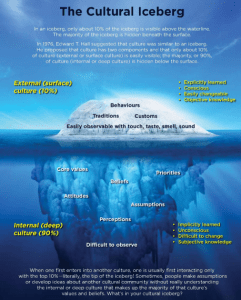Introducing Cultural Awareness
There are a lot of variations of lenses in the scope of culture. Culture is a type of scope; the many different lenses make up a culture, such as race, beliefs, values, customs, traditions, and language within our society. Over the years, we have created awareness of the importance of accepting these differences between people, but we have yet to overcome cultural barriers. Our goal today is to open up the topic of the importance of cultural awareness.
Culture is an Iceberg
The University of Central Arkansas created “Culture as an Iceberg,” which is an iceberg representation of the cultural struggles. The analogy about cultural difficulties and how we can only see so much from the outside (tip of the iceberg above water) as a society. However, we cannot know all the significant difficulties (bottom of the iceberg beneath the water).
Within the external surface of an iceberg or in the surface culture, only 10% is visible. In contrast, 90% of the iceberg or internal culture is not visual. As a society, we focus on behaviors, traditions, customs, and anything observable with touch, taste, smell, and sound. However, there is so much more to culture, such as beliefs, priorities, attitudes, perceptions, or core values.
There are different lenses to look through in the scope of what culture. Each lens is another aspect of what creates a culture. Recently, we have seen how much cultural incompetence exists in our world. Race has the spotlight because most people are looking through the race lens. Expanding our knowledge of what culture is and what it holds would be the best solution to becoming culturally competent.
Cultural Barrier- Communication
A cultural barrier starts when there is a misunderstanding of meaning which is caused by cultural differences between the sender and the receiver. It usually creates conflict and stress. The most common barrier is communication because of the diversity.
Communication can be expressed in various ways such as symbols, signs, behavior, and language. It is the way people express themselves and relate with other people. According to NSW Health there are ways to overcome communication barriers by:
- Checking whether it is a good time and place to communicate with the person
- Being clear and using the language the person understands
- Communicating one thing at a time
- Respecting a person’s desire to not communicate
- Checking that the person has understood you correctly
- Communication in a location that is free of distractions
- Acknowledging any emotional responses the person has to what you have said
Doing Our Part
Today more than ever, organizations are looking to provide a cultural competence framework to improve teamwork, innovation, and customer experience. At OYE, we are excited to announce that our CEO, Natasha Pongonis, is working with the Global Fluency Institute to provide cross-cultural competence training to executives and professionals in the US.
Global Fluency Institute (GFI) provides professionals with awareness, tools, and confidence to interact and collaborate with people from different cultural backgrounds. The global economy and communities now demand that all employees with different cultural backgrounds work together. GFI provides the hands-on training professionals need to succeed in a diverse environment.

